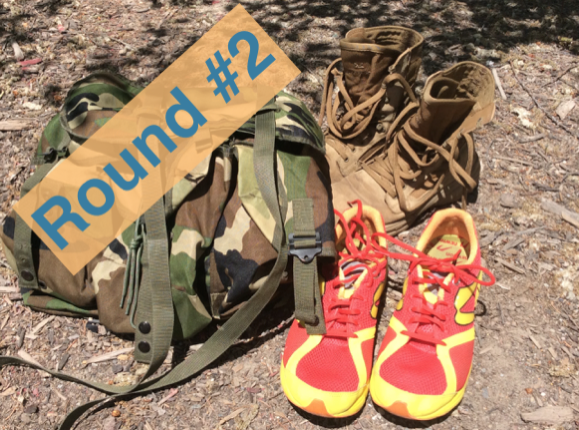
by Kyle Bochanski
In one of our recent Mini-Studies, we looked at how pack weight compares to foot weight.
We found that for a slow hiking pace (2mph@15% grade), an additional 1 pound on your feet was equal to carrying 4 pounds on your back. Ultimately, the addition of pounds on your feet or back only changes your heart rate by about 10 beats/minute. This implies that unless you are out to break a speed record, dropping money for the lighter shoes won’t make that much of a difference (strictly comparing products by weight).
With this Mini-Study, we aim to answer the question that our previous study generated, “Does the 4 to 1 ratio hold true at faster speeds?”
Mini-Study Design
To determine the relationship between foot and pack weight we used the same method. We generated two regression equations showing the relationship of weight to physical demand. Then we compared weights at the same physical demands. The graph below shows the regression for pack weight (orange line) and shoe weight (blue line).
We found the amount of weight in your pack required for the same physical exertion on your foot actually dropped. The ratio for 4mph at a 0% grade is about two. This means wearing “boots that are 8 pounds on your feet is the physiological equivalent of carrying 16 pounds on your pack.

We used heart rate to compare the weight on your feet versus weight in your pack.
These results are surprising. A higher cadence should have made the ratio greater since the subject was swinging their foot back and forth more. We expected the higher cadence of 125 steps/minute at 4 mph to make a larger difference for the foot to pack weight ratio than the 100 steps/minute at 2mph but did not find this to be true.
A possible explanation of this unexpected finding is that higher cadence has a greater impact on pack weight versus foot weight.
Ultimately, the ratio does not matter. Changes in heart rate as a result of increased foot weight are minimal.
Practical Implications
The study presented the same implications as last week. Changing shoe weight from 3 to 12 pounds only changed heart rate from 115 to 125 beats/minute. The huge weight change and small heart rate change means spending money to lighten shoe weight is only worth it if you are looking for marginal gains in your performance.
For example, the $629 Maestrale RS Alpine Touring Ski Boots 2017 Size 27 weigh 3.44 lbs and the $330 Maestrale GT Alpine Touring Ski Boots 2015 weight size 27 weigh 4.14 lbs. For an extra $229, the drop in your heart rate for shedding a pound is probably not worth it.
Take-Home Message
If you’re looking at two shoes with the same functionality that differ by a couple of pounds or more than the extra cost for lighter shoes is not worth it.
Feedback, Comments, Questions? Email coach@mtntactical.com or comment below
You Might Also Like Mini-Study Finds 1 Lb On Your Feet = 4 Lbs On Your Back for Slow Hiking Pace
